Detailed Analysis of Food Handling Policy in Aged Care, Brisbane
VerifiedAdded on 2022/10/09
|17
|3645
|203
Essay
AI Summary
This essay undertakes a thorough examination of food handling policies within the aged care sector, specifically focusing on facilities in Brisbane. It commences with an introduction emphasizing the critical role of food safety in maintaining hygiene and protecting vulnerable individuals, referencing relevant standards from Food Standards Australia New Zealand. The study then delves into the policy cycle, outlining its phases from agenda setting to maintenance, and highlighting its significance in aged care settings. The analysis incorporates environmental assessments through fishbone analysis, identifying potential causes of food safety issues. Additionally, a force field analysis is employed to evaluate factors supporting and hindering policy changes. The essay further explores stakeholder engagement, detailing the roles of various stakeholders such as management, supervisors, cooking professionals, the government, and patients. Policy planning is discussed, emphasizing the significance of standardization and risk management. The essay concludes by highlighting the importance of compliance with food safety standards and the effective implementation of policies to ensure the health and safety of aged care residents. The analysis uses models like 7S strategy and change management to describe policy implementation.
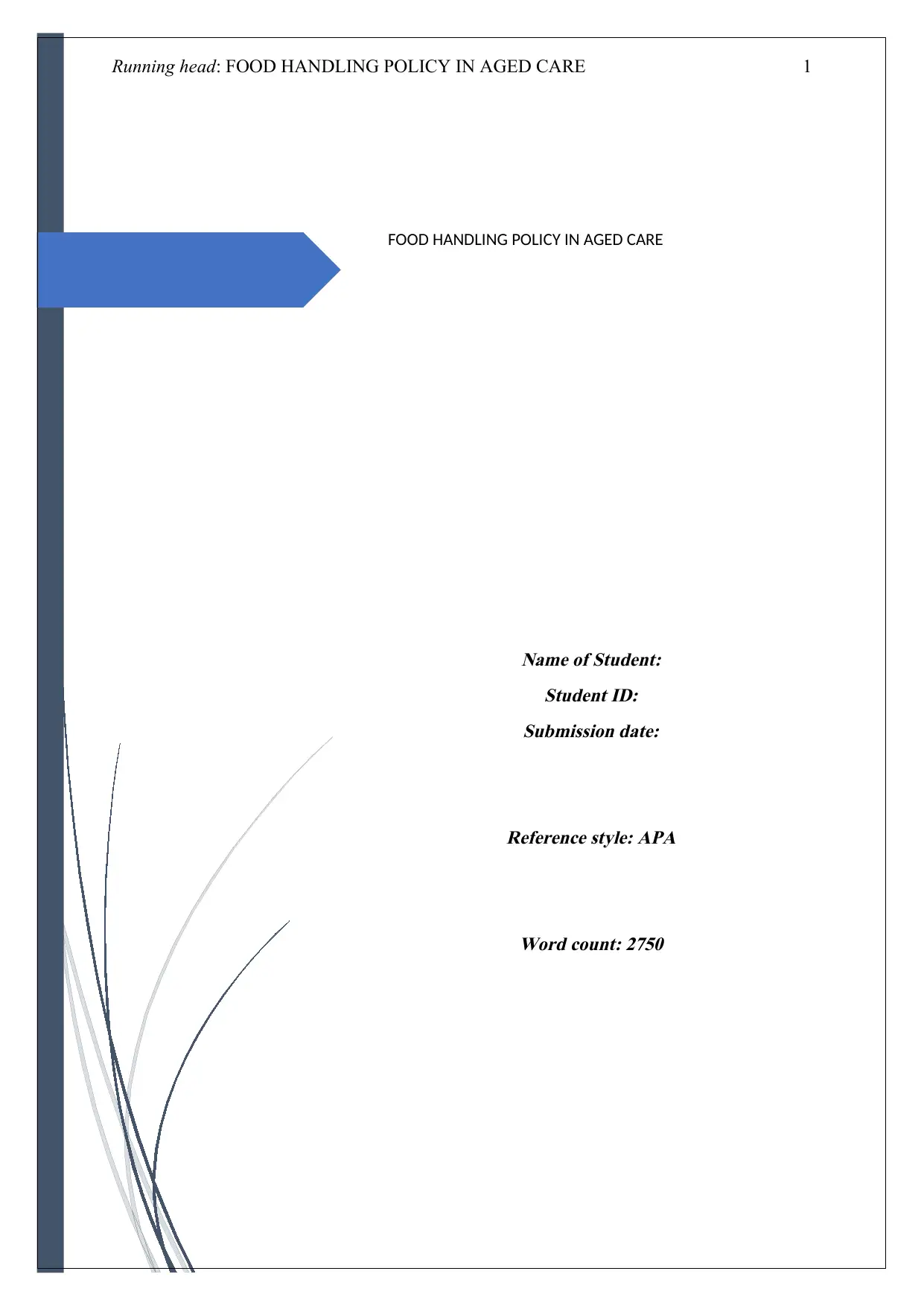
Running head: FOOD HANDLING POLICY IN AGED CARE 1
FOOD HANDLING POLICY IN AGED CARE
Name of Student:
Student ID:
Submission date:
Reference style: APA
Word count: 2750
FOOD HANDLING POLICY IN AGED CARE
Name of Student:
Student ID:
Submission date:
Reference style: APA
Word count: 2750
Paraphrase This Document
Need a fresh take? Get an instant paraphrase of this document with our AI Paraphraser
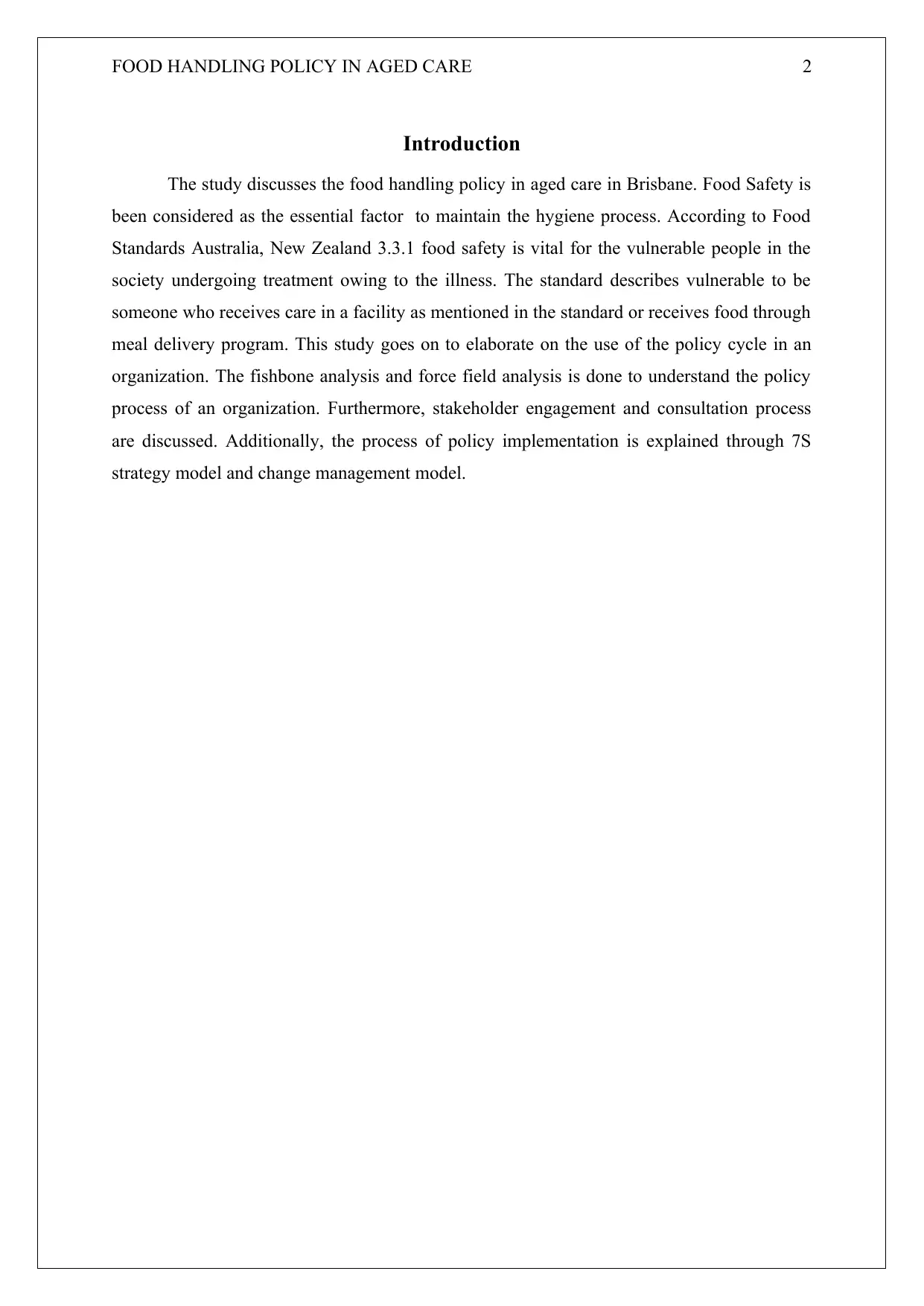
FOOD HANDLING POLICY IN AGED CARE 2
Introduction
The study discusses the food handling policy in aged care in Brisbane. Food Safety is
been considered as the essential factor to maintain the hygiene process. According to Food
Standards Australia, New Zealand 3.3.1 food safety is vital for the vulnerable people in the
society undergoing treatment owing to the illness. The standard describes vulnerable to be
someone who receives care in a facility as mentioned in the standard or receives food through
meal delivery program. This study goes on to elaborate on the use of the policy cycle in an
organization. The fishbone analysis and force field analysis is done to understand the policy
process of an organization. Furthermore, stakeholder engagement and consultation process
are discussed. Additionally, the process of policy implementation is explained through 7S
strategy model and change management model.
Introduction
The study discusses the food handling policy in aged care in Brisbane. Food Safety is
been considered as the essential factor to maintain the hygiene process. According to Food
Standards Australia, New Zealand 3.3.1 food safety is vital for the vulnerable people in the
society undergoing treatment owing to the illness. The standard describes vulnerable to be
someone who receives care in a facility as mentioned in the standard or receives food through
meal delivery program. This study goes on to elaborate on the use of the policy cycle in an
organization. The fishbone analysis and force field analysis is done to understand the policy
process of an organization. Furthermore, stakeholder engagement and consultation process
are discussed. Additionally, the process of policy implementation is explained through 7S
strategy model and change management model.
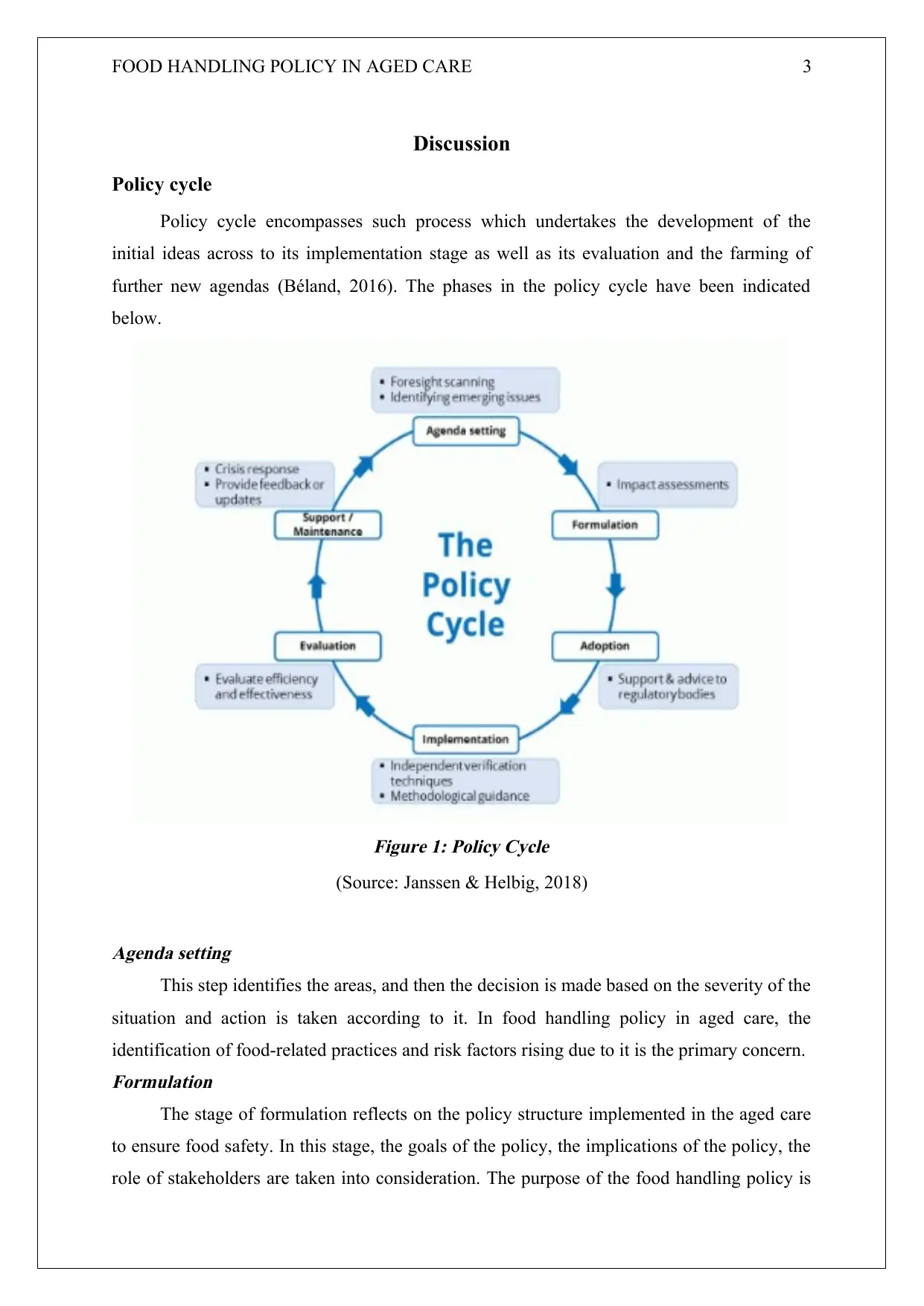
FOOD HANDLING POLICY IN AGED CARE 3
Discussion
Policy cycle
Policy cycle encompasses such process which undertakes the development of the
initial ideas across to its implementation stage as well as its evaluation and the farming of
further new agendas (Béland, 2016). The phases in the policy cycle have been indicated
below.
Figure 1: Policy Cycle
(Source: Janssen & Helbig, 2018)
Agenda setting
This step identifies the areas, and then the decision is made based on the severity of the
situation and action is taken according to it. In food handling policy in aged care, the
identification of food-related practices and risk factors rising due to it is the primary concern.Formulation
The stage of formulation reflects on the policy structure implemented in the aged care
to ensure food safety. In this stage, the goals of the policy, the implications of the policy, the
role of stakeholders are taken into consideration. The purpose of the food handling policy is
Discussion
Policy cycle
Policy cycle encompasses such process which undertakes the development of the
initial ideas across to its implementation stage as well as its evaluation and the farming of
further new agendas (Béland, 2016). The phases in the policy cycle have been indicated
below.
Figure 1: Policy Cycle
(Source: Janssen & Helbig, 2018)
Agenda setting
This step identifies the areas, and then the decision is made based on the severity of the
situation and action is taken according to it. In food handling policy in aged care, the
identification of food-related practices and risk factors rising due to it is the primary concern.Formulation
The stage of formulation reflects on the policy structure implemented in the aged care
to ensure food safety. In this stage, the goals of the policy, the implications of the policy, the
role of stakeholders are taken into consideration. The purpose of the food handling policy is
⊘ This is a preview!⊘
Do you want full access?
Subscribe today to unlock all pages.

Trusted by 1+ million students worldwide
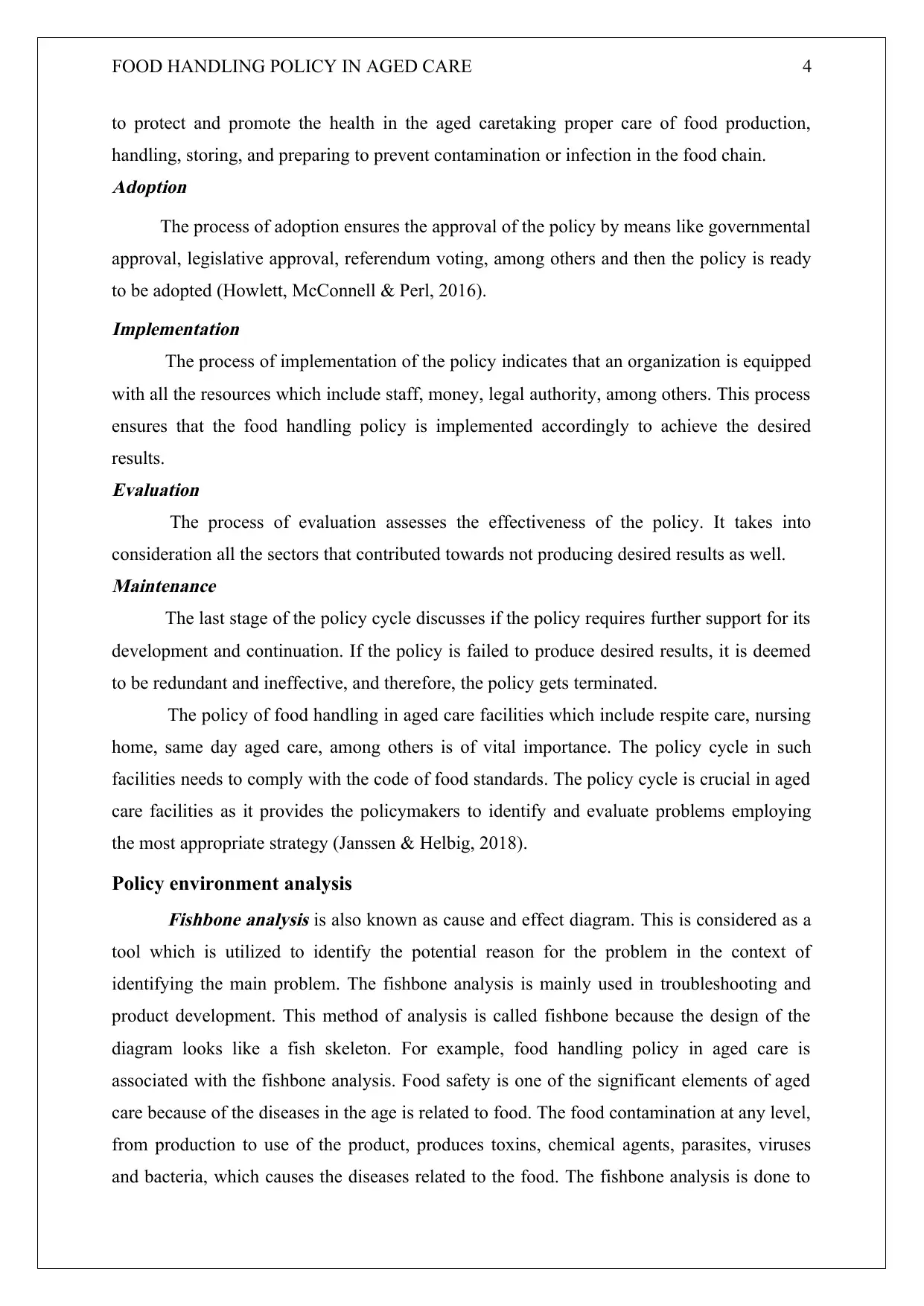
FOOD HANDLING POLICY IN AGED CARE 4
to protect and promote the health in the aged caretaking proper care of food production,
handling, storing, and preparing to prevent contamination or infection in the food chain.Adoption
The process of adoption ensures the approval of the policy by means like governmental
approval, legislative approval, referendum voting, among others and then the policy is ready
to be adopted (Howlett, McConnell & Perl, 2016).Implementation
The process of implementation of the policy indicates that an organization is equipped
with all the resources which include staff, money, legal authority, among others. This process
ensures that the food handling policy is implemented accordingly to achieve the desired
results.Evaluation
The process of evaluation assesses the effectiveness of the policy. It takes into
consideration all the sectors that contributed towards not producing desired results as well.Maintenance
The last stage of the policy cycle discusses if the policy requires further support for its
development and continuation. If the policy is failed to produce desired results, it is deemed
to be redundant and ineffective, and therefore, the policy gets terminated.
The policy of food handling in aged care facilities which include respite care, nursing
home, same day aged care, among others is of vital importance. The policy cycle in such
facilities needs to comply with the code of food standards. The policy cycle is crucial in aged
care facilities as it provides the policymakers to identify and evaluate problems employing
the most appropriate strategy (Janssen & Helbig, 2018).
Policy environment analysisFishbone analysis is also known as cause and effect diagram. This is considered as a
tool which is utilized to identify the potential reason for the problem in the context of
identifying the main problem. The fishbone analysis is mainly used in troubleshooting and
product development. This method of analysis is called fishbone because the design of the
diagram looks like a fish skeleton. For example, food handling policy in aged care is
associated with the fishbone analysis. Food safety is one of the significant elements of aged
care because of the diseases in the age is related to food. The food contamination at any level,
from production to use of the product, produces toxins, chemical agents, parasites, viruses
and bacteria, which causes the diseases related to the food. The fishbone analysis is done to
to protect and promote the health in the aged caretaking proper care of food production,
handling, storing, and preparing to prevent contamination or infection in the food chain.Adoption
The process of adoption ensures the approval of the policy by means like governmental
approval, legislative approval, referendum voting, among others and then the policy is ready
to be adopted (Howlett, McConnell & Perl, 2016).Implementation
The process of implementation of the policy indicates that an organization is equipped
with all the resources which include staff, money, legal authority, among others. This process
ensures that the food handling policy is implemented accordingly to achieve the desired
results.Evaluation
The process of evaluation assesses the effectiveness of the policy. It takes into
consideration all the sectors that contributed towards not producing desired results as well.Maintenance
The last stage of the policy cycle discusses if the policy requires further support for its
development and continuation. If the policy is failed to produce desired results, it is deemed
to be redundant and ineffective, and therefore, the policy gets terminated.
The policy of food handling in aged care facilities which include respite care, nursing
home, same day aged care, among others is of vital importance. The policy cycle in such
facilities needs to comply with the code of food standards. The policy cycle is crucial in aged
care facilities as it provides the policymakers to identify and evaluate problems employing
the most appropriate strategy (Janssen & Helbig, 2018).
Policy environment analysisFishbone analysis is also known as cause and effect diagram. This is considered as a
tool which is utilized to identify the potential reason for the problem in the context of
identifying the main problem. The fishbone analysis is mainly used in troubleshooting and
product development. This method of analysis is called fishbone because the design of the
diagram looks like a fish skeleton. For example, food handling policy in aged care is
associated with the fishbone analysis. Food safety is one of the significant elements of aged
care because of the diseases in the age is related to food. The food contamination at any level,
from production to use of the product, produces toxins, chemical agents, parasites, viruses
and bacteria, which causes the diseases related to the food. The fishbone analysis is done to
Paraphrase This Document
Need a fresh take? Get an instant paraphrase of this document with our AI Paraphraser
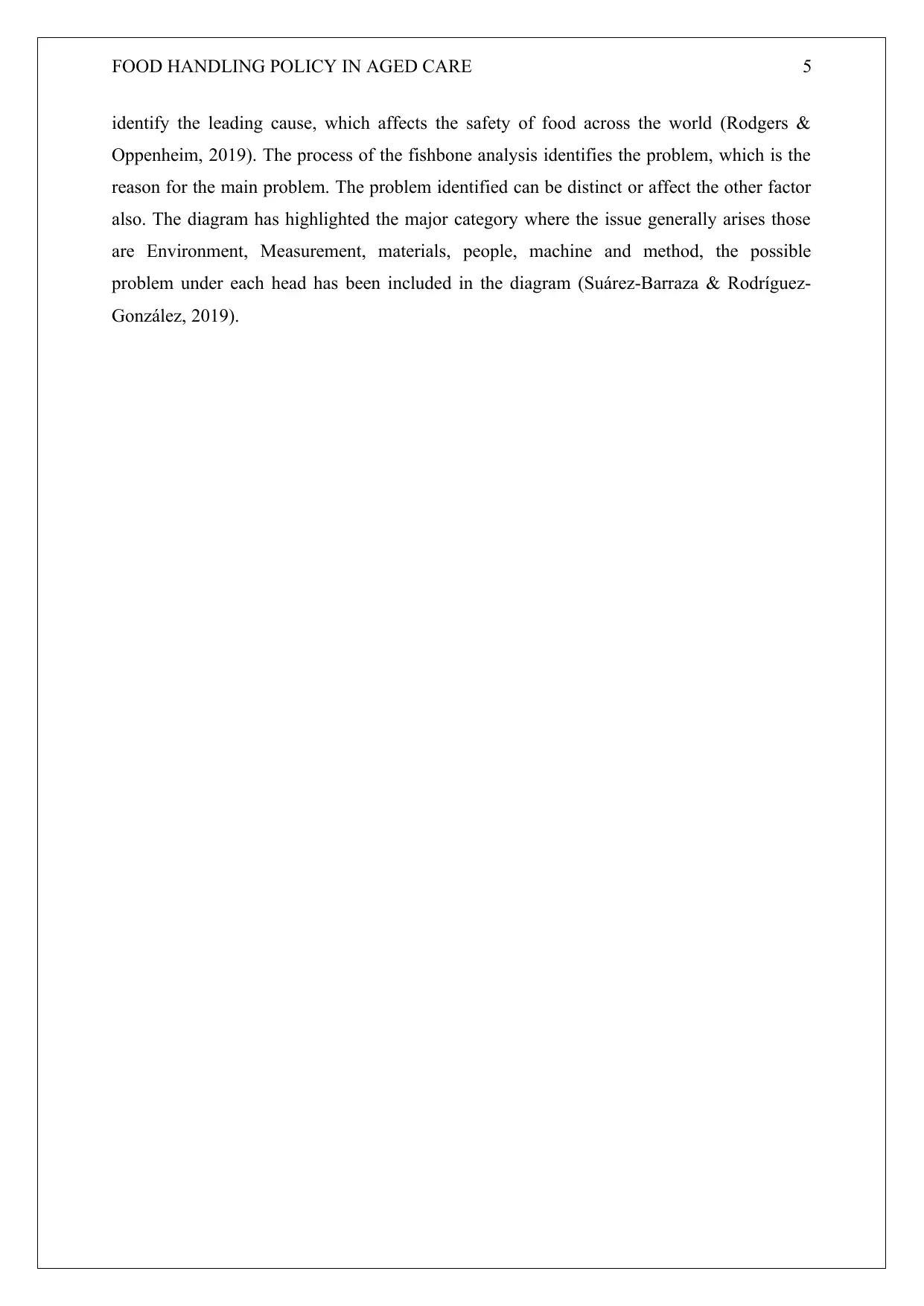
FOOD HANDLING POLICY IN AGED CARE 5
identify the leading cause, which affects the safety of food across the world (Rodgers &
Oppenheim, 2019). The process of the fishbone analysis identifies the problem, which is the
reason for the main problem. The problem identified can be distinct or affect the other factor
also. The diagram has highlighted the major category where the issue generally arises those
are Environment, Measurement, materials, people, machine and method, the possible
problem under each head has been included in the diagram (Suárez-Barraza & Rodríguez-
González, 2019).
identify the leading cause, which affects the safety of food across the world (Rodgers &
Oppenheim, 2019). The process of the fishbone analysis identifies the problem, which is the
reason for the main problem. The problem identified can be distinct or affect the other factor
also. The diagram has highlighted the major category where the issue generally arises those
are Environment, Measurement, materials, people, machine and method, the possible
problem under each head has been included in the diagram (Suárez-Barraza & Rodríguez-
González, 2019).
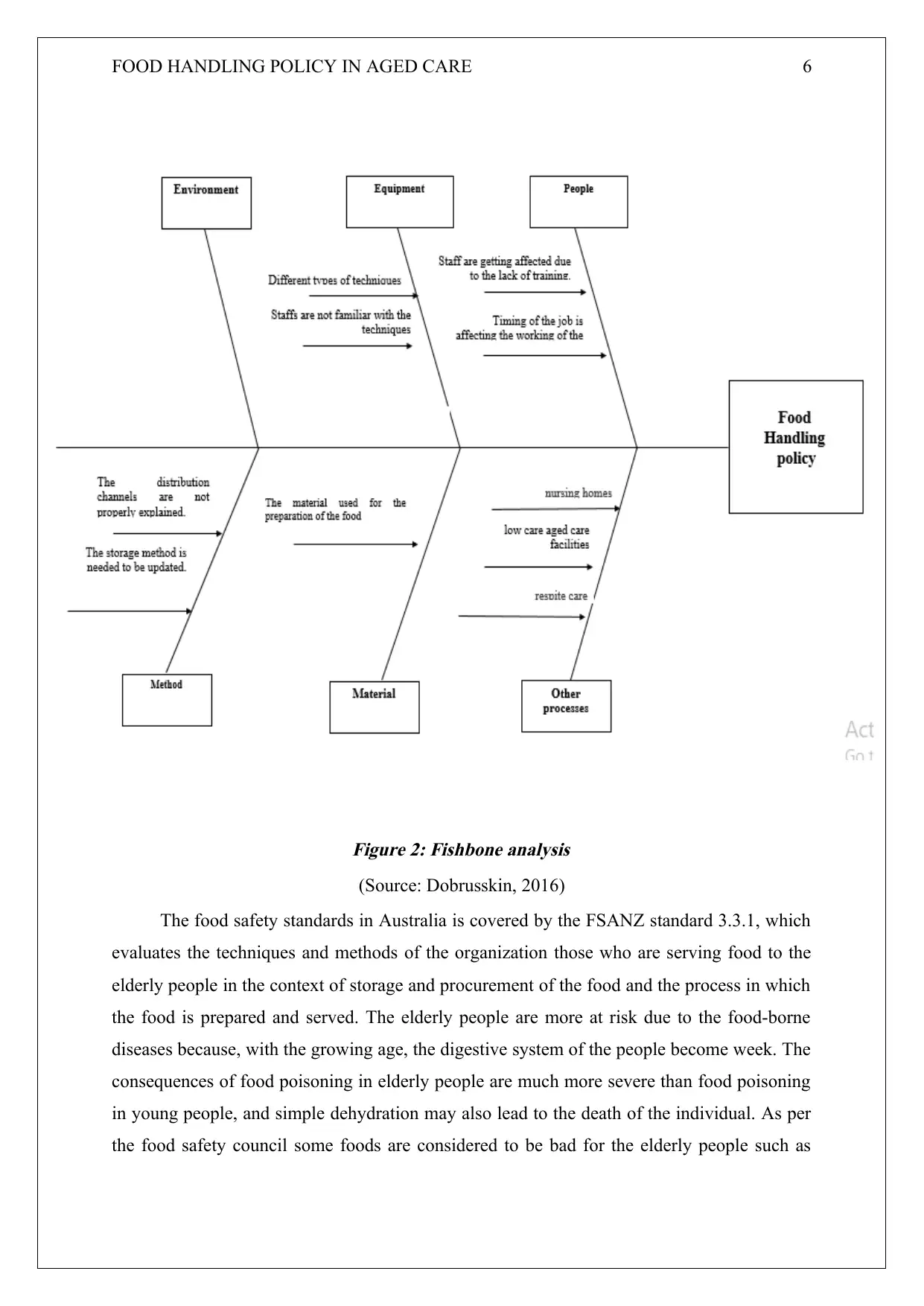
FOOD HANDLING POLICY IN AGED CARE 6
Figure 2: Fishbone analysis
(Source: Dobrusskin, 2016)
The food safety standards in Australia is covered by the FSANZ standard 3.3.1, which
evaluates the techniques and methods of the organization those who are serving food to the
elderly people in the context of storage and procurement of the food and the process in which
the food is prepared and served. The elderly people are more at risk due to the food-borne
diseases because, with the growing age, the digestive system of the people become week. The
consequences of food poisoning in elderly people are much more severe than food poisoning
in young people, and simple dehydration may also lead to the death of the individual. As per
the food safety council some foods are considered to be bad for the elderly people such as
Figure 2: Fishbone analysis
(Source: Dobrusskin, 2016)
The food safety standards in Australia is covered by the FSANZ standard 3.3.1, which
evaluates the techniques and methods of the organization those who are serving food to the
elderly people in the context of storage and procurement of the food and the process in which
the food is prepared and served. The elderly people are more at risk due to the food-borne
diseases because, with the growing age, the digestive system of the people become week. The
consequences of food poisoning in elderly people are much more severe than food poisoning
in young people, and simple dehydration may also lead to the death of the individual. As per
the food safety council some foods are considered to be bad for the elderly people such as
⊘ This is a preview!⊘
Do you want full access?
Subscribe today to unlock all pages.

Trusted by 1+ million students worldwide
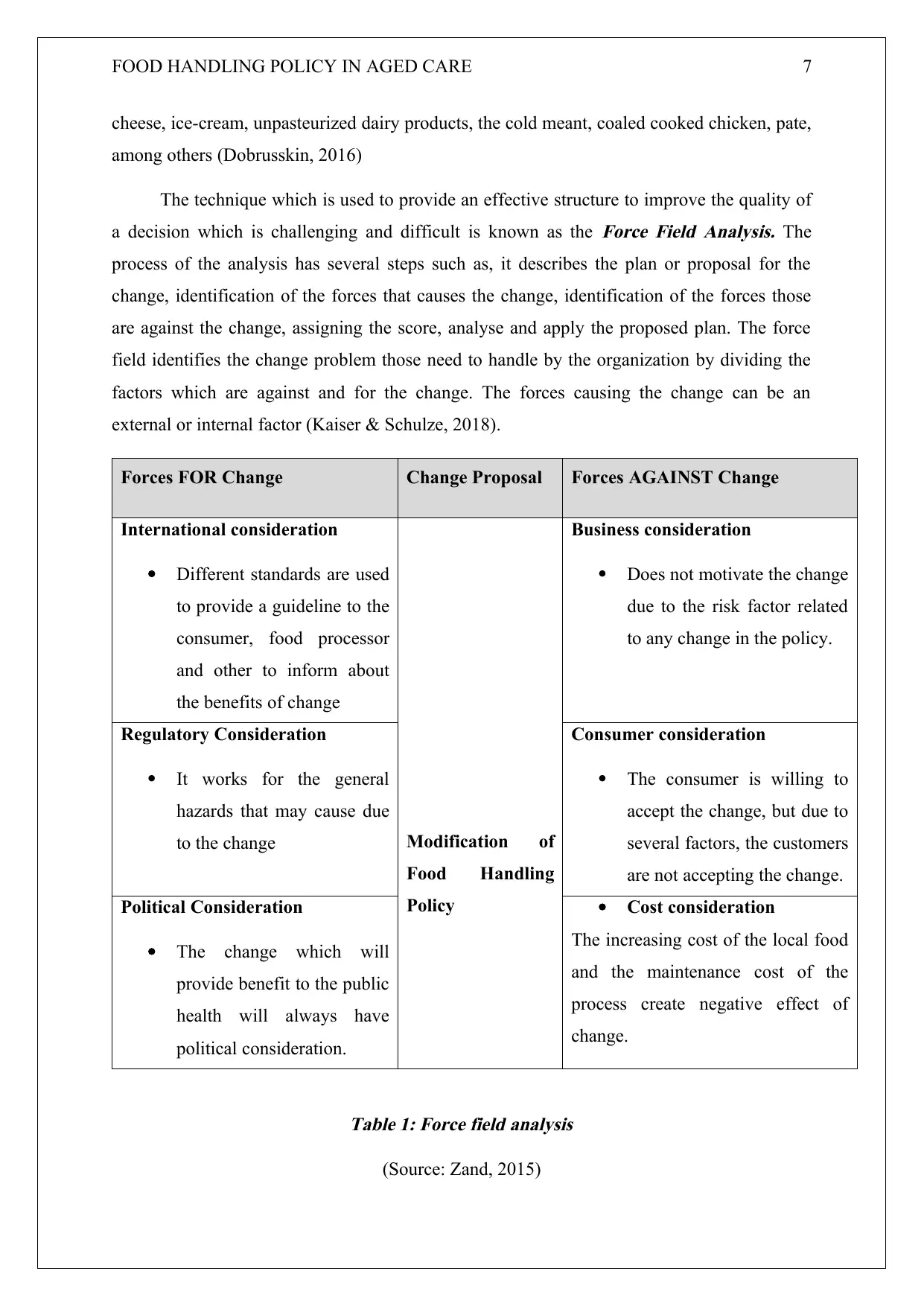
FOOD HANDLING POLICY IN AGED CARE 7
cheese, ice-cream, unpasteurized dairy products, the cold meant, coaled cooked chicken, pate,
among others (Dobrusskin, 2016)
The technique which is used to provide an effective structure to improve the quality of
a decision which is challenging and difficult is known as the
Force Field Analysis. The
process of the analysis has several steps such as, it describes the plan or proposal for the
change, identification of the forces that causes the change, identification of the forces those
are against the change, assigning the score, analyse and apply the proposed plan. The force
field identifies the change problem those need to handle by the organization by dividing the
factors which are against and for the change. The forces causing the change can be an
external or internal factor (Kaiser & Schulze, 2018).
Forces FOR Change Change Proposal Forces AGAINST Change
International consideration
Different standards are used
to provide a guideline to the
consumer, food processor
and other to inform about
the benefits of change
Modification of
Food Handling
Policy
Business consideration
Does not motivate the change
due to the risk factor related
to any change in the policy.
Regulatory Consideration
It works for the general
hazards that may cause due
to the change
Consumer consideration
The consumer is willing to
accept the change, but due to
several factors, the customers
are not accepting the change.
Political Consideration
The change which will
provide benefit to the public
health will always have
political consideration.
Cost consideration
The increasing cost of the local food
and the maintenance cost of the
process create negative effect of
change.Table 1: Force field analysis
(Source: Zand, 2015)
cheese, ice-cream, unpasteurized dairy products, the cold meant, coaled cooked chicken, pate,
among others (Dobrusskin, 2016)
The technique which is used to provide an effective structure to improve the quality of
a decision which is challenging and difficult is known as the
Force Field Analysis. The
process of the analysis has several steps such as, it describes the plan or proposal for the
change, identification of the forces that causes the change, identification of the forces those
are against the change, assigning the score, analyse and apply the proposed plan. The force
field identifies the change problem those need to handle by the organization by dividing the
factors which are against and for the change. The forces causing the change can be an
external or internal factor (Kaiser & Schulze, 2018).
Forces FOR Change Change Proposal Forces AGAINST Change
International consideration
Different standards are used
to provide a guideline to the
consumer, food processor
and other to inform about
the benefits of change
Modification of
Food Handling
Policy
Business consideration
Does not motivate the change
due to the risk factor related
to any change in the policy.
Regulatory Consideration
It works for the general
hazards that may cause due
to the change
Consumer consideration
The consumer is willing to
accept the change, but due to
several factors, the customers
are not accepting the change.
Political Consideration
The change which will
provide benefit to the public
health will always have
political consideration.
Cost consideration
The increasing cost of the local food
and the maintenance cost of the
process create negative effect of
change.Table 1: Force field analysis
(Source: Zand, 2015)
Paraphrase This Document
Need a fresh take? Get an instant paraphrase of this document with our AI Paraphraser
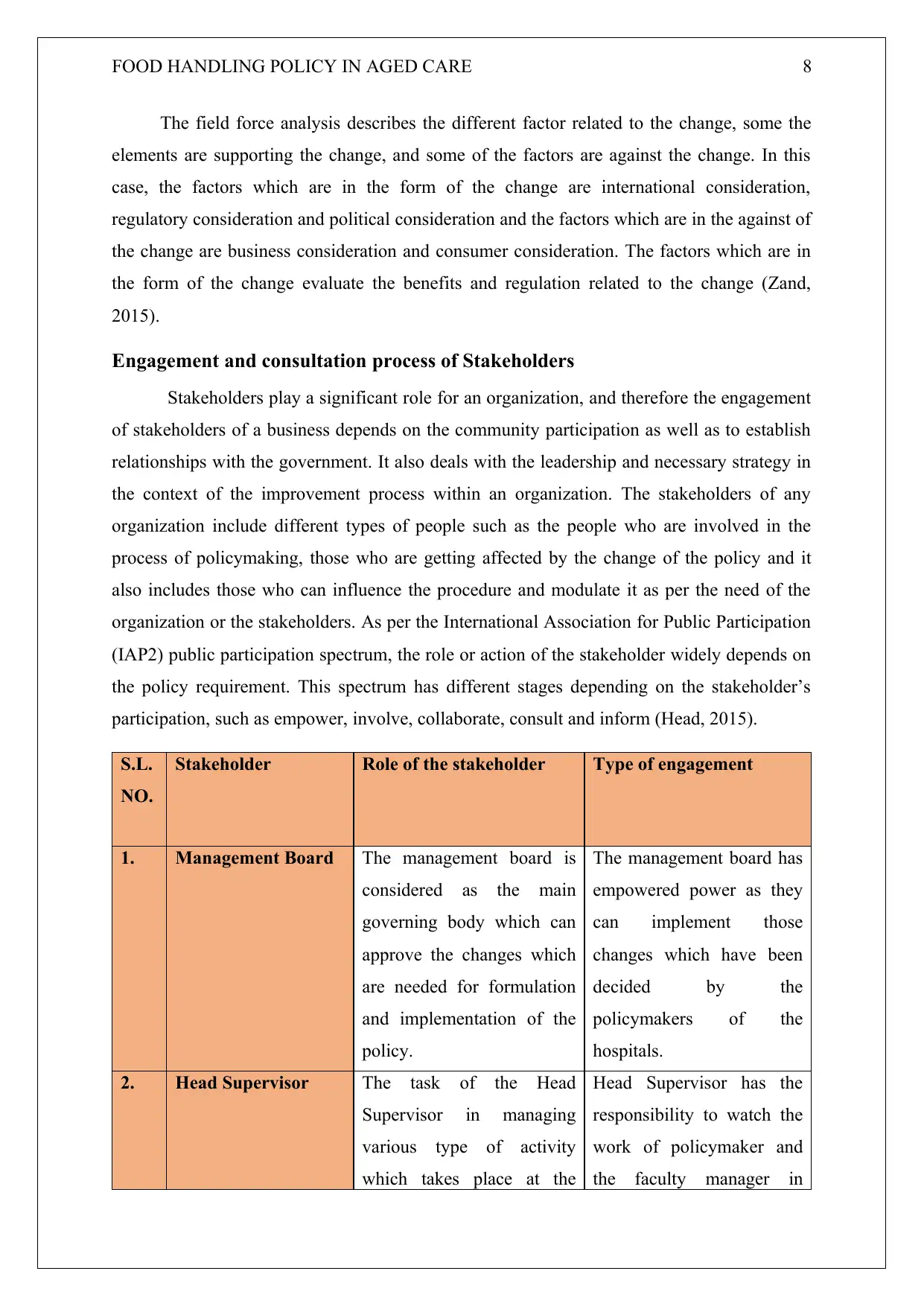
FOOD HANDLING POLICY IN AGED CARE 8
The field force analysis describes the different factor related to the change, some the
elements are supporting the change, and some of the factors are against the change. In this
case, the factors which are in the form of the change are international consideration,
regulatory consideration and political consideration and the factors which are in the against of
the change are business consideration and consumer consideration. The factors which are in
the form of the change evaluate the benefits and regulation related to the change (Zand,
2015).
Engagement and consultation process of Stakeholders
Stakeholders play a significant role for an organization, and therefore the engagement
of stakeholders of a business depends on the community participation as well as to establish
relationships with the government. It also deals with the leadership and necessary strategy in
the context of the improvement process within an organization. The stakeholders of any
organization include different types of people such as the people who are involved in the
process of policymaking, those who are getting affected by the change of the policy and it
also includes those who can influence the procedure and modulate it as per the need of the
organization or the stakeholders. As per the International Association for Public Participation
(IAP2) public participation spectrum, the role or action of the stakeholder widely depends on
the policy requirement. This spectrum has different stages depending on the stakeholder’s
participation, such as empower, involve, collaborate, consult and inform (Head, 2015).
S.L.
NO.
Stakeholder Role of the stakeholder Type of engagement
1. Management Board The management board is
considered as the main
governing body which can
approve the changes which
are needed for formulation
and implementation of the
policy.
The management board has
empowered power as they
can implement those
changes which have been
decided by the
policymakers of the
hospitals.
2. Head Supervisor The task of the Head
Supervisor in managing
various type of activity
which takes place at the
Head Supervisor has the
responsibility to watch the
work of policymaker and
the faculty manager in
The field force analysis describes the different factor related to the change, some the
elements are supporting the change, and some of the factors are against the change. In this
case, the factors which are in the form of the change are international consideration,
regulatory consideration and political consideration and the factors which are in the against of
the change are business consideration and consumer consideration. The factors which are in
the form of the change evaluate the benefits and regulation related to the change (Zand,
2015).
Engagement and consultation process of Stakeholders
Stakeholders play a significant role for an organization, and therefore the engagement
of stakeholders of a business depends on the community participation as well as to establish
relationships with the government. It also deals with the leadership and necessary strategy in
the context of the improvement process within an organization. The stakeholders of any
organization include different types of people such as the people who are involved in the
process of policymaking, those who are getting affected by the change of the policy and it
also includes those who can influence the procedure and modulate it as per the need of the
organization or the stakeholders. As per the International Association for Public Participation
(IAP2) public participation spectrum, the role or action of the stakeholder widely depends on
the policy requirement. This spectrum has different stages depending on the stakeholder’s
participation, such as empower, involve, collaborate, consult and inform (Head, 2015).
S.L.
NO.
Stakeholder Role of the stakeholder Type of engagement
1. Management Board The management board is
considered as the main
governing body which can
approve the changes which
are needed for formulation
and implementation of the
policy.
The management board has
empowered power as they
can implement those
changes which have been
decided by the
policymakers of the
hospitals.
2. Head Supervisor The task of the Head
Supervisor in managing
various type of activity
which takes place at the
Head Supervisor has the
responsibility to watch the
work of policymaker and
the faculty manager in
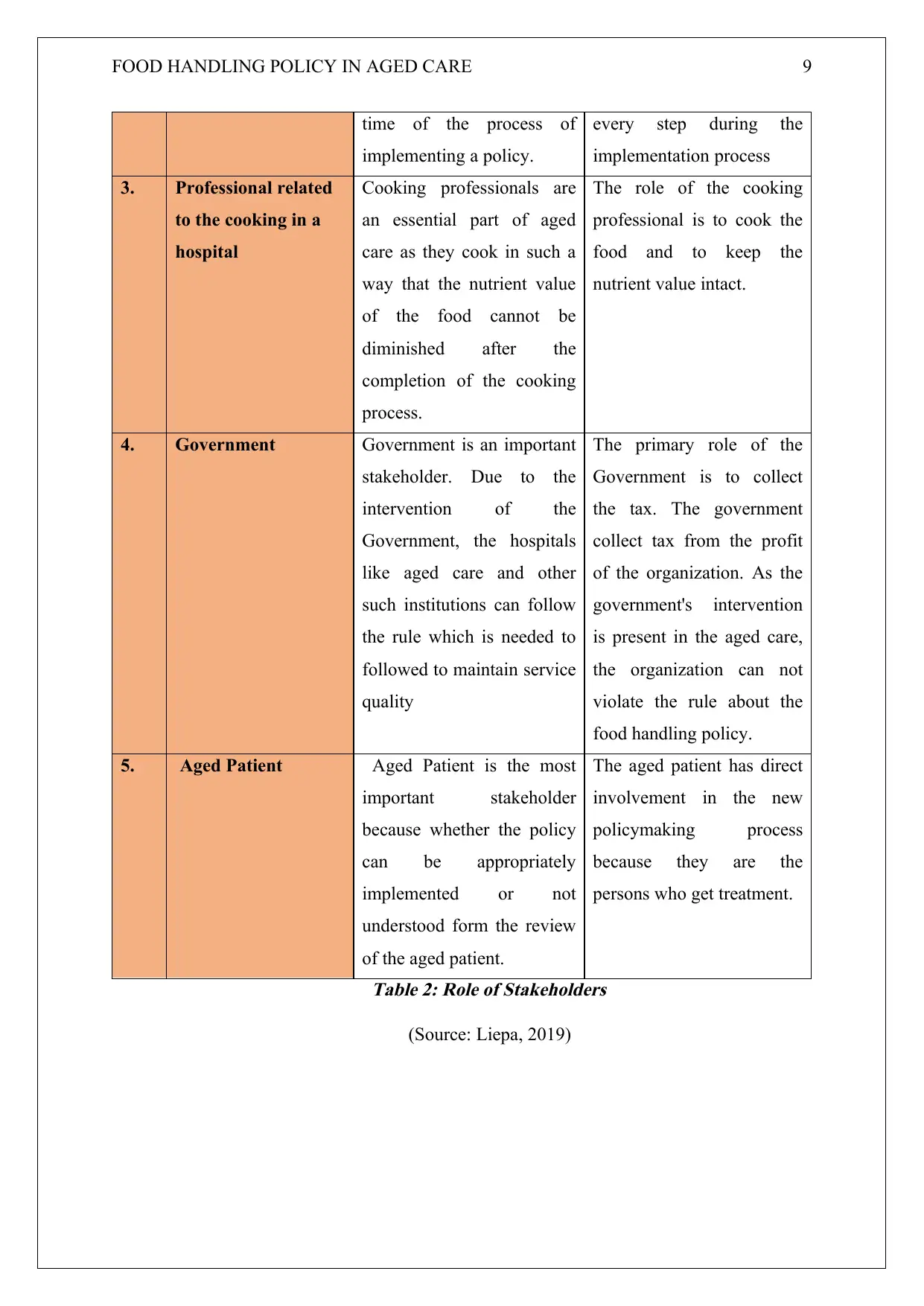
FOOD HANDLING POLICY IN AGED CARE 9
time of the process of
implementing a policy.
every step during the
implementation process
3. Professional related
to the cooking in a
hospital
Cooking professionals are
an essential part of aged
care as they cook in such a
way that the nutrient value
of the food cannot be
diminished after the
completion of the cooking
process.
The role of the cooking
professional is to cook the
food and to keep the
nutrient value intact.
4. Government Government is an important
stakeholder. Due to the
intervention of the
Government, the hospitals
like aged care and other
such institutions can follow
the rule which is needed to
followed to maintain service
quality
The primary role of the
Government is to collect
the tax. The government
collect tax from the profit
of the organization. As the
government's intervention
is present in the aged care,
the organization can not
violate the rule about the
food handling policy.
5. Aged Patient Aged Patient is the most
important stakeholder
because whether the policy
can be appropriately
implemented or not
understood form the review
of the aged patient.
The aged patient has direct
involvement in the new
policymaking process
because they are the
persons who get treatment.Table 2: Role of Stakeholders
(Source: Liepa, 2019)
time of the process of
implementing a policy.
every step during the
implementation process
3. Professional related
to the cooking in a
hospital
Cooking professionals are
an essential part of aged
care as they cook in such a
way that the nutrient value
of the food cannot be
diminished after the
completion of the cooking
process.
The role of the cooking
professional is to cook the
food and to keep the
nutrient value intact.
4. Government Government is an important
stakeholder. Due to the
intervention of the
Government, the hospitals
like aged care and other
such institutions can follow
the rule which is needed to
followed to maintain service
quality
The primary role of the
Government is to collect
the tax. The government
collect tax from the profit
of the organization. As the
government's intervention
is present in the aged care,
the organization can not
violate the rule about the
food handling policy.
5. Aged Patient Aged Patient is the most
important stakeholder
because whether the policy
can be appropriately
implemented or not
understood form the review
of the aged patient.
The aged patient has direct
involvement in the new
policymaking process
because they are the
persons who get treatment.Table 2: Role of Stakeholders
(Source: Liepa, 2019)
⊘ This is a preview!⊘
Do you want full access?
Subscribe today to unlock all pages.

Trusted by 1+ million students worldwide
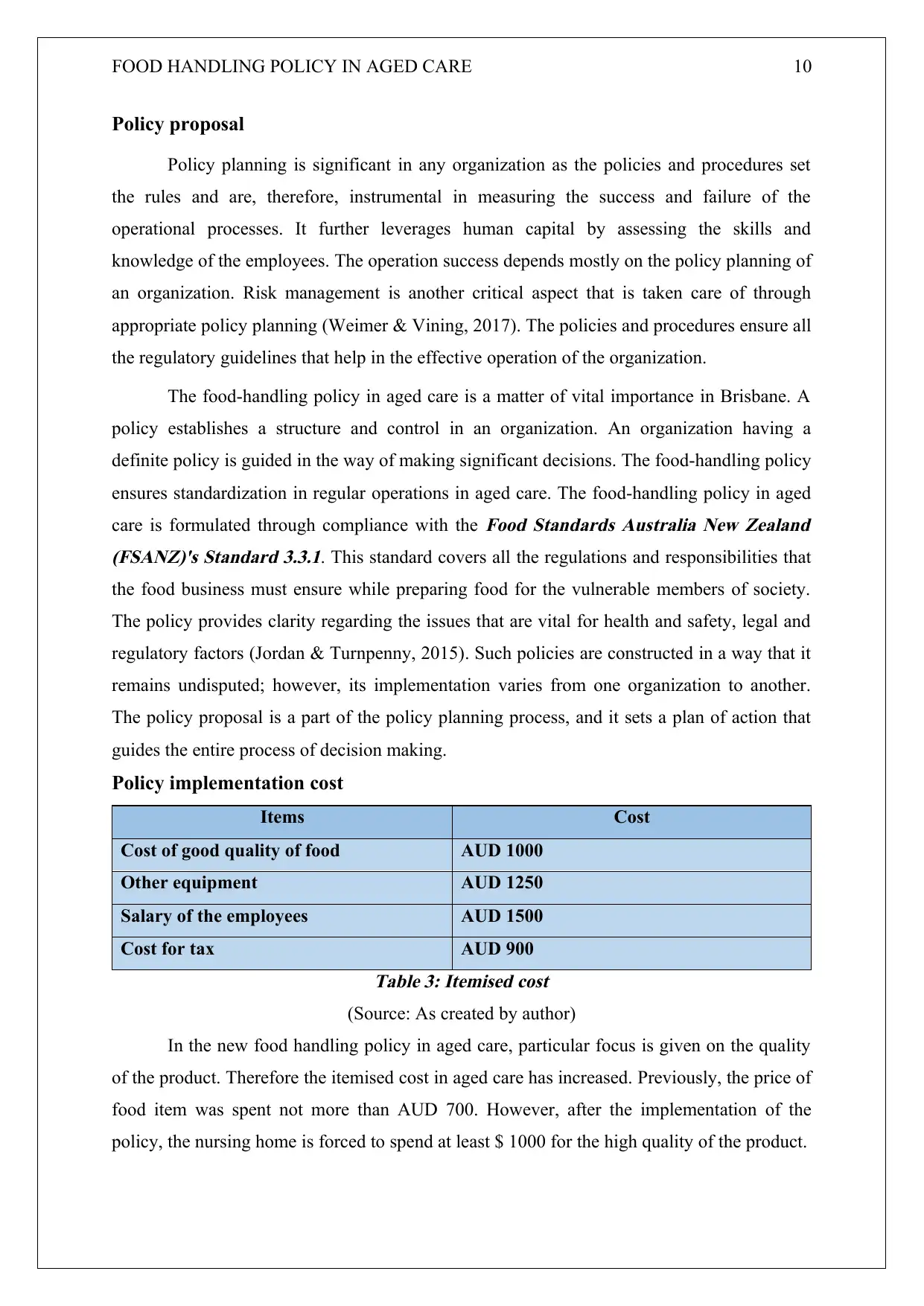
FOOD HANDLING POLICY IN AGED CARE 10
Policy proposal
Policy planning is significant in any organization as the policies and procedures set
the rules and are, therefore, instrumental in measuring the success and failure of the
operational processes. It further leverages human capital by assessing the skills and
knowledge of the employees. The operation success depends mostly on the policy planning of
an organization. Risk management is another critical aspect that is taken care of through
appropriate policy planning (Weimer & Vining, 2017). The policies and procedures ensure all
the regulatory guidelines that help in the effective operation of the organization.
The food-handling policy in aged care is a matter of vital importance in Brisbane. A
policy establishes a structure and control in an organization. An organization having a
definite policy is guided in the way of making significant decisions. The food-handling policy
ensures standardization in regular operations in aged care. The food-handling policy in aged
care is formulated through compliance with the
Food Standards Australia New Zealand
(FSANZ)'s Standard 3.3.1. This standard covers all the regulations and responsibilities that
the food business must ensure while preparing food for the vulnerable members of society.
The policy provides clarity regarding the issues that are vital for health and safety, legal and
regulatory factors (Jordan & Turnpenny, 2015). Such policies are constructed in a way that it
remains undisputed; however, its implementation varies from one organization to another.
The policy proposal is a part of the policy planning process, and it sets a plan of action that
guides the entire process of decision making.
Policy implementation cost
Items Cost
Cost of good quality of food AUD 1000
Other equipment AUD 1250
Salary of the employees AUD 1500
Cost for tax AUD 900
Table 3: Itemised cost
(Source: As created by author)
In the new food handling policy in aged care, particular focus is given on the quality
of the product. Therefore the itemised cost in aged care has increased. Previously, the price of
food item was spent not more than AUD 700. However, after the implementation of the
policy, the nursing home is forced to spend at least $ 1000 for the high quality of the product.
Policy proposal
Policy planning is significant in any organization as the policies and procedures set
the rules and are, therefore, instrumental in measuring the success and failure of the
operational processes. It further leverages human capital by assessing the skills and
knowledge of the employees. The operation success depends mostly on the policy planning of
an organization. Risk management is another critical aspect that is taken care of through
appropriate policy planning (Weimer & Vining, 2017). The policies and procedures ensure all
the regulatory guidelines that help in the effective operation of the organization.
The food-handling policy in aged care is a matter of vital importance in Brisbane. A
policy establishes a structure and control in an organization. An organization having a
definite policy is guided in the way of making significant decisions. The food-handling policy
ensures standardization in regular operations in aged care. The food-handling policy in aged
care is formulated through compliance with the
Food Standards Australia New Zealand
(FSANZ)'s Standard 3.3.1. This standard covers all the regulations and responsibilities that
the food business must ensure while preparing food for the vulnerable members of society.
The policy provides clarity regarding the issues that are vital for health and safety, legal and
regulatory factors (Jordan & Turnpenny, 2015). Such policies are constructed in a way that it
remains undisputed; however, its implementation varies from one organization to another.
The policy proposal is a part of the policy planning process, and it sets a plan of action that
guides the entire process of decision making.
Policy implementation cost
Items Cost
Cost of good quality of food AUD 1000
Other equipment AUD 1250
Salary of the employees AUD 1500
Cost for tax AUD 900
Table 3: Itemised cost
(Source: As created by author)
In the new food handling policy in aged care, particular focus is given on the quality
of the product. Therefore the itemised cost in aged care has increased. Previously, the price of
food item was spent not more than AUD 700. However, after the implementation of the
policy, the nursing home is forced to spend at least $ 1000 for the high quality of the product.
Paraphrase This Document
Need a fresh take? Get an instant paraphrase of this document with our AI Paraphraser
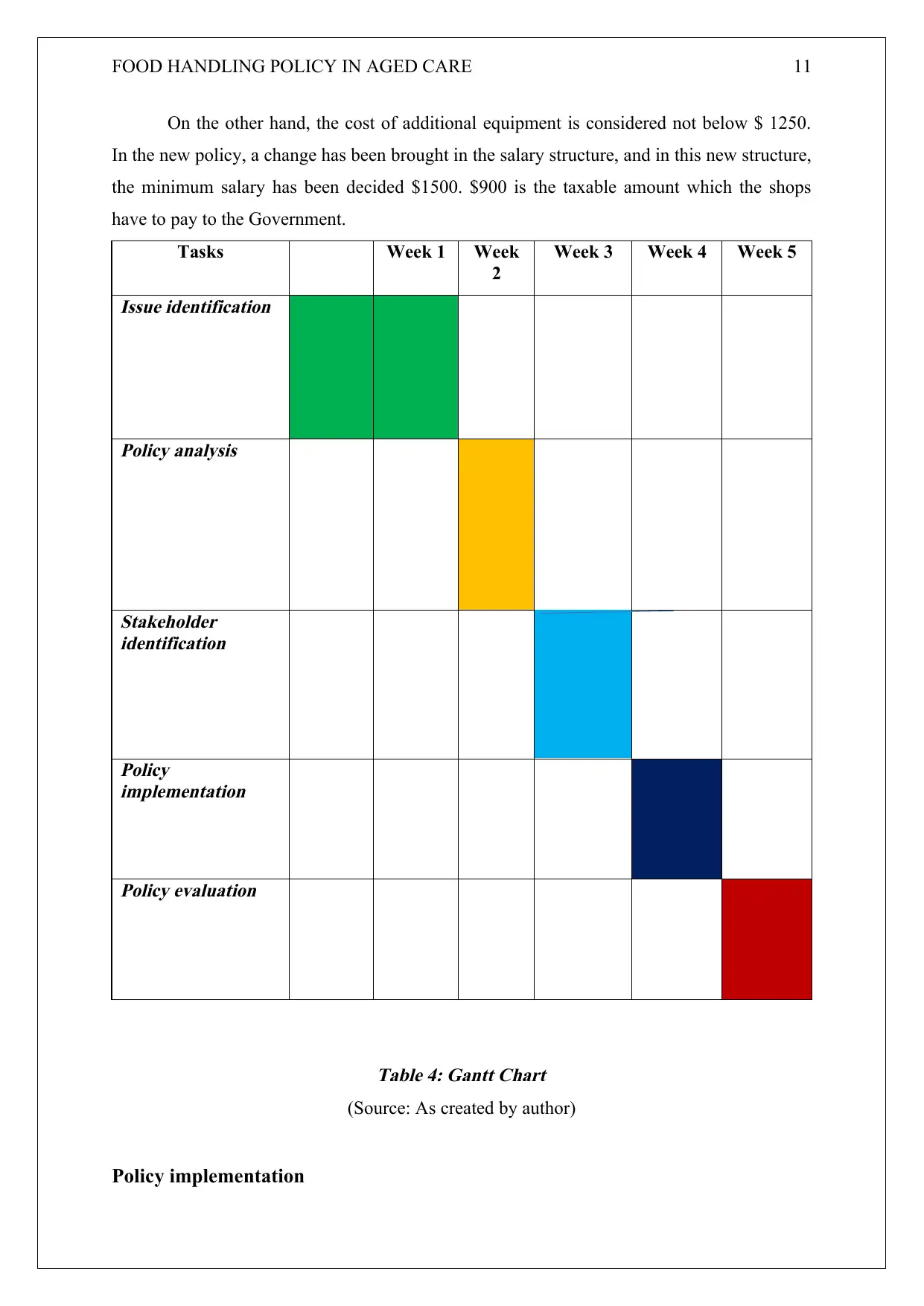
FOOD HANDLING POLICY IN AGED CARE 11
On the other hand, the cost of additional equipment is considered not below $ 1250.
In the new policy, a change has been brought in the salary structure, and in this new structure,
the minimum salary has been decided $1500. $900 is the taxable amount which the shops
have to pay to the Government.
Tasks Week 1 Week
2
Week 3 Week 4 Week 5
Issue identification
Policy analysis
Stakeholder
identification
Policy
implementation
Policy evaluation
Table 4: Gantt Chart
(Source: As created by author)
Policy implementation
On the other hand, the cost of additional equipment is considered not below $ 1250.
In the new policy, a change has been brought in the salary structure, and in this new structure,
the minimum salary has been decided $1500. $900 is the taxable amount which the shops
have to pay to the Government.
Tasks Week 1 Week
2
Week 3 Week 4 Week 5
Issue identification
Policy analysis
Stakeholder
identification
Policy
implementation
Policy evaluation
Table 4: Gantt Chart
(Source: As created by author)
Policy implementation
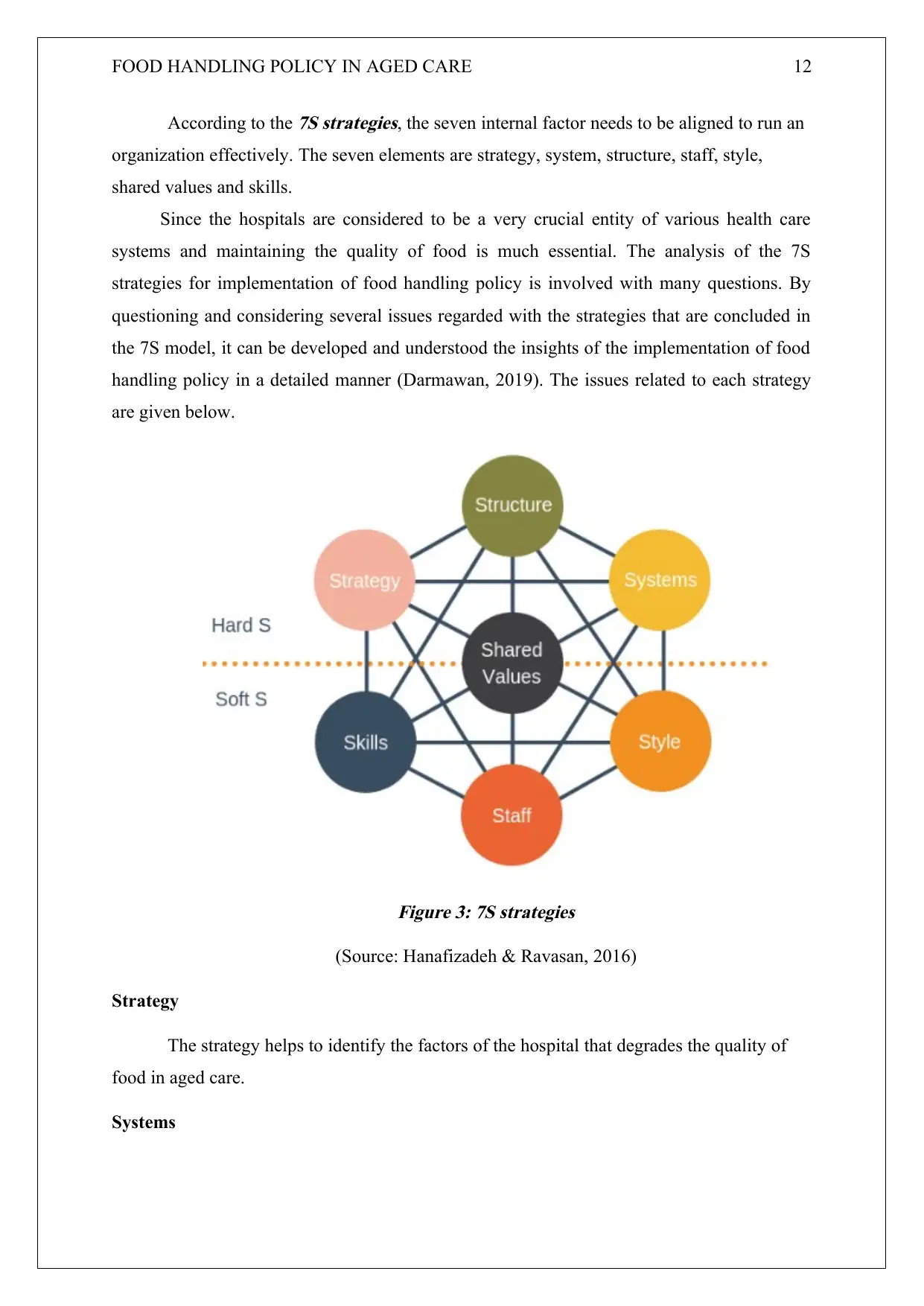
FOOD HANDLING POLICY IN AGED CARE 12
According to the
7S strategies, the seven internal factor needs to be aligned to run an
organization effectively. The seven elements are strategy, system, structure, staff, style,
shared values and skills.
Since the hospitals are considered to be a very crucial entity of various health care
systems and maintaining the quality of food is much essential. The analysis of the 7S
strategies for implementation of food handling policy is involved with many questions. By
questioning and considering several issues regarded with the strategies that are concluded in
the 7S model, it can be developed and understood the insights of the implementation of food
handling policy in a detailed manner (Darmawan, 2019). The issues related to each strategy
are given below.
Figure 3: 7S strategies
(Source: Hanafizadeh & Ravasan, 2016)
Strategy
The strategy helps to identify the factors of the hospital that degrades the quality of
food in aged care.
Systems
According to the
7S strategies, the seven internal factor needs to be aligned to run an
organization effectively. The seven elements are strategy, system, structure, staff, style,
shared values and skills.
Since the hospitals are considered to be a very crucial entity of various health care
systems and maintaining the quality of food is much essential. The analysis of the 7S
strategies for implementation of food handling policy is involved with many questions. By
questioning and considering several issues regarded with the strategies that are concluded in
the 7S model, it can be developed and understood the insights of the implementation of food
handling policy in a detailed manner (Darmawan, 2019). The issues related to each strategy
are given below.
Figure 3: 7S strategies
(Source: Hanafizadeh & Ravasan, 2016)
Strategy
The strategy helps to identify the factors of the hospital that degrades the quality of
food in aged care.
Systems
⊘ This is a preview!⊘
Do you want full access?
Subscribe today to unlock all pages.

Trusted by 1+ million students worldwide
1 out of 17
Related Documents
Your All-in-One AI-Powered Toolkit for Academic Success.
+13062052269
info@desklib.com
Available 24*7 on WhatsApp / Email
![[object Object]](/_next/static/media/star-bottom.7253800d.svg)
Unlock your academic potential
Copyright © 2020–2025 A2Z Services. All Rights Reserved. Developed and managed by ZUCOL.



